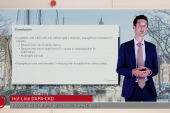PRESERVED-HF: Dapagliflozin Improves Symptoms, Physical Limitations in HFpEF
“This is the largest KCCQ benefit ever reported in any trial with a drug for HFrEF or HFpEF,” Milton Packer notes.

Dapagliflozin (Farxiga; AstraZeneca) eases symptoms and physical limitations among patients who have heart failure with preserved ejection fraction (HFpEF) within a relatively short time period, the PRESERVED-HF trial shows, adding to recent evidence supporting the benefits of sodium-glucose cotransporter 2 (SGLT2) inhibition in this difficult-to-treat population.
After 12 weeks of treatment, improvement in the Kansas City Cardiomyopathy Questionnaire (KCCQ) clinical summary score was 5.8 points greater in patients treated with dapagliflozin versus placebo (P = 0.001), Mikhail Kosiborod, MD (Saint Luke’s Mid America Heart Institute, Kansas City, MO), reported Sunday at the Heart Failure Society of America 2021 meeting in Denver, CO.
“The effect was large, clinically meaningful, and statistically significant,” he said, noting that the finding was consistent across key subgroups defined by diabetes status, baseline LVEF, and other variables. “PRESERVED-HF, to our knowledge, is the first trial to demonstrate that [the] SGLT2 inhibitor dapagliflozin significantly improves symptoms, physical limitations, and 6-minute walking distance in patients with HFpEF,” Kosiborod said.
The results, which are in press in Nature Medicine, complement those from large trials focused on clinical outcomes, he said, “and collectively support the use of SGLT2 inhibitors as a new treatment option in HFpEF, which is a morbid condition with few therapeutic options. This, in our opinion, should have implications for clinical practice.”
After the presentation, Milton Packer, MD (Baylor Heart and Vascular Institute, Houston, TX), addressed Kosiborod from the audience, calling the results “really impressive” and “unprecedented,” pointing out that “this is the largest KCCQ benefit ever reported in any trial with a drug for HFrEF or HFpEF.”
Kosiborod said the larger effect observed here compared with other trials of SGLT2 inhibitors likely has to do with the types of patients enrolled in PRESERVED-HF, who had a much lower baseline KCCQ score, heavier symptom burden, and greater functional impairment than patients in other studies.
PRESERVED-HF
Patients with a preserved ejection fraction make up more than half of all heart failure cases now, with the prevalence of HFpEF increasing in the United States, Kosiborod noted. Relieving symptoms and physical limitations in this group are key goals of management, he said, pointing out that “there has been a wide range of therapies that have been tested in this disease condition on these particular outcomes with minimal impact, highlighting a critical unmet clinical need.”
SGLT2 inhibitors, including dapagliflozin and empagliflozin (Jardiance; Boehringer Ingelheim/Eli Lilly), were initially developed to treat type 2 diabetes but have since been shown to reduce CV death and worsening heart failure and to improve symptoms and physical limitations in HFrEF. Recently reported results of the EMPEROR-Preserved trial demonstrate that empagliflozin lowers the risk of CV death/hospitalization for heart failure in HFpEF, but the impact of SGLT2 inhibition on symptoms, physical limitations, and exercise function in this population has remained unclear.
PRESERVED-HF, conducted at 26 US centers, was designed to address this question. Investigators randomized 324 patients (mean age of about 70 years; 57% women) with NYHA class II to IV symptoms, an LVEF of 45% or higher, elevated natriuretic peptides, a requirement for diuretic therapy, and at least one of the following enrichment factors: a recent HF hospitalization or urgent HF visit requiring IV diuretics, elevated filling pressure by right or left heart catheterization, or structural heart disease on an echocardiogram.
The average duration of heart failure was about 3 years, with a median LVEF of 60%. More than half of patients had type 2 diabetes (56%) and atrial fibrillation (53%). Median body mass index was 35 kg/m2—much higher than in previous HFpEF trial, Kosiborod noted—and more than 40% of patients had NYHA class III or IV symptoms. In addition, the median 6-minute walk distance was 244 meters. These characteristics indicate “substantial symptomatic and functional impairment at baseline,” he said.
The primary endpoint was the KCCQ clinical summary score, which includes symptoms and physical limitations, at 12 weeks. Starting from a “quite low” baseline, patients treated with dapagliflozin saw significant improvements in the clinical summary score, as well as the individual components: total symptom score was 5.8 points better than in the placebo group and the physical limitation score was 5.3 points better. Each of these differences was “clinically meaningful and statistically significant,” Kosiborod said.
The impact of dapagliflozin was consistent across subgroups, including those defined by the presence of type 2 diabetes, baseline LVEF (divided at the 60% threshold), sex, race, age, and others.
Patients who received the SGLT2 inhibitors also were significantly more likely to have a clinically meaningful improvement—at least 5 points—in the KCCQ clinical summary score, with a number needed to treat of 9.
Moreover, active treatment led a significant improvement in 6-minute walk distance, with a between-group difference of 20.1 meters (P = 0.007), and in the KCCQ overall summary score, with a between-group difference of 4.5 points (P = 0.009).
There were no differences between the trial arms in terms of natriuretic peptides, glycated hemoglobin, or systolic blood pressure, although dapagliflozin resulted in a modest reduction in weight (by 0.72 kg; P = 0.046).
Kosiborod said safety events were balanced between the groups, with no severe hypoglycemic events, lower-limb amputations, or cases of diabetic ketoacidosis in the trial.
Making Patients Feel Better
After his presentation, Kosiborod was asked about the consistency of the treatment benefit in patients with an LVEF above or below the median of 60%, a key question in the context of discussions after the results of EMPEROR-Preserved were reported. A pooled analysis of that trial and EMPEROR-Reduced suggested that the benefits of empagliflozin in terms of hard clinical outcomes faded at higher EFs, and there was no hint of that happening with the outcomes in PRESERVED-HF.
Kosiborod said the relevance of a cutoff at 60% remains to be seen. “I personally think that these outcomes [in PRESERVED-HF] are just as important as survival and hospitalizations,” he said, noting that many patients would be willing to trade some quantity of life for better quality of life. “So I think we need to look at the whole gamut, the whole spectrum, of outcomes and certainly we see zero evidence of any interaction of treatment benefit by ejection fraction of 60% or less.”
Commenting for TCTMD, Shelley Zieroth, MD (University of Manitoba, Winnipeg, Canada), past president of the Canadian Heart Failure Society, said PRESERVED-HF is the first study to show that SGLT2 inhibition improves symptoms and physical limitations in a HFpEF population.
Whether benefits are lost over a certain LVEF threshold will continue to be a point of discussion moving forward, but the current results will make physicians who may be hesitant to prescribe SGLT2 inhibitors in HFpEF patients with higher EFs to rethink that stance, Zieroth said.
“This data with dapagliflozin adds to the totality of evidence for use of these agents in HFpEF,” she said. “And it’s also important not only to reduce clinical events but to make our patients feel better as well.”
Todd Neale is the Associate News Editor for TCTMD and a Senior Medical Journalist. He got his start in journalism at …
Read Full BioSources
Kosiborod M. Effects of dapagliflozin on symptoms, function, and quality of life in patients with heart failure and preserved ejection fraction: main results from the PRESERVED-HF trial. Presented at: HFSA 2021. September 12, 2021. Denver, CO.
Disclosures
- PRESERVED-HF was funded by AstraZeneca.
- Kosiborod reports research grants from AstraZeneca and Boehringer Ingelheim and clinical trial leadership/consulting/advisory board relationships with Amgen, AstraZeneca, Bayer, Boehringer Ingelheim, Janssen, Eli Lilly, Merck, Novo Nordisk, Sanofi, and Vifor.
- Zieroth reports having received speaker and consulting fees from Boehringer Ingelheim and Eli Lilly and serving as National Lead for the EMPULSE and EMPACT-MI clinical trials.





Comments